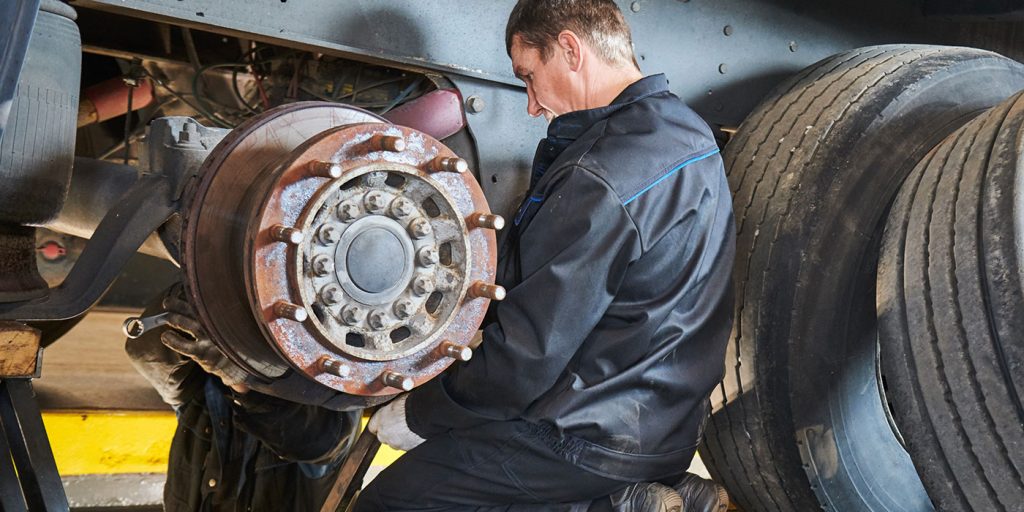It’s important that your technicians are trained on how to spot brake wear, and that your shops have systems and schedules in place aimed at avoiding wear issues on brakes.
“The only real way to keep an eye out for irregular brake wear is visual inspection on both drum and disc systems. Spotting irregular wear provides early troubleshooting evidence that the systems might not be working optimally and can save some headaches down the road,” says Keith McComsey, director of marketing and customer solutions (wheel-end) with Bendix Spicer Foundation Brake. “There is a lot of talk about air disc brakes [ADBs] being more robust with extended service intervals; however, that does not replace doing routine service inspections.”
A visual inspection should cover the following, according to Tony Ryan, technical services and training manager for SAF-Holland:
- Inspect for secure mounting, wear, leaks, corrosion and damage.
- Check for loose, broken or cracked air hoses, air system leaks and damaged components.
- Check that brake hoses and cables are properly secured.
- For proper brake pad wear, check that there is enough clearance to allow the caliper full movement during normal operation.
- Check the spring brake chambers to make sure the parking springs are not caged in the released position. Be sure the dust plugs are properly installed.
- Make sure that the vent holes in the air brake chamber are not covered with snow, ice, mud, etc.
- Inspect the wheel-bearing unit for grease leaks at every brake pad change.
- Visually check the brake assembly (e.g. pads, rotor, etc.) for oil or grease contamination.
- Check that all dust caps and boots are present and in good condition.
- Regularly conduct general safety checks in accordance with any applicable laws.
- After every wheel change, the wheel nuts must be re-tightened to the specified torque level after the initial 100 miles of operation, and then at every regular service interval.
From there, you need to go beyond the visual inspection, according to Bendix’s McComsey. He recommends the following extra steps:
- Look at the slack adjusters to make sure they are at equal angles during parking brake apply, in the at-rest position and brake pedal apply.
- Lubricate the clevis pins and make sure the pins are not loose or frozen in the slack/clevis.
- Measure applied stroke at 90 to 100 PSI and make sure they are equal at all wheel ends. Follow the out-of-service guidelines for chamber size.
“Keep in mind: This is how DOT/FMCSA checks to see if your brakes are out of adjustment, which can lead to them being taken out of service,” McComsey points out.
Additional maintenance tips
“A comprehensive preventative maintenance program includes two critical components: maintaining good records and understanding your operating conditions,” says Greg Dvorchak, engineering supervisor of application engineering for wheel ends and braking systems with Hendrickson Trailer Commercial Vehicle Systems. “Dynamics like average length of haul, application, terrain, driver patterns and tractor-trailer equipment combinations are important factors to consider when determining intervals at which brake linings should be replaced.”
Dvorchak also recommends choosing replacement parts carefully. “When deciding between OEM vs. non-OEM replacement components, consider performance and lifespan implications that come along with each of these options,” he says. “OEM friction materials are rigorously tested for performance, wear and structural integrity. Unfortunately, some aftermarket brakes do not undergo the same stringent testing standards as OEM brake parts, so even though a customer may think they are getting an equivalent part to the original equipment spec, brake performance and lifespan could vary greatly.”
According to Jay Urban, senior product manager for air disc brakes with Meritor, the first and most important thing you can do is get a feel for the brake’s replacement intervals through periodic inspection.
“If your fleet hasn’t used air disc brakes before,” he notes, “there will be a need to step up the frequency of inspections and ensure that your maintenance team has a strong understanding of what components to check and how to measure the current state.”
This, Urban says, is key to realizing the ROI of air disc brakes as opposed to drum brakes—which can be much more difficult if maintenance is not kept up to date.
“Part of this ROI is tied up in the fact that, when compared head-to-head, brake pad changes on air disc brakes take much less time for technicians to complete than brake shoe changes on drum brakes,” he adds. “This ROI can reverse, though, if the brake pads are allowed to wear too much, wearing off all of the friction lining, and the steel backing plates begin to make contact with the brake rotors. This state will cause damaging wear to the rotor; a much more costly repair than replacing brake pads. If enough of these expensive repairs take place due to inability of the maintenance program to monitor and replace brake pads, the overall ROI of the air disc brake decision may be in question.”
Read more about drum brakes vs. disc brakes here.
Montu Khokhar, chief executive officer of NRS Brakes, singled out one specific thing for technicians to look for: rust.
“Rust kills any hope you had to get maximum mileage out of your brake pads,” he elaborates. “Avoid rust by buying brake pads with galvanized backing plates, and ensure these pads are American- or Canadian-made. These brake pads don’t use rusted steel like those made in China.
“Remember that the price of the brake pad set is irrelevant when comparing it to the cost of the actual brake job, and the bigger cost of fleet vehicles sitting in the bay when they should be working and improving your overall profitability,” he adds.
Read our full story on the importance of keeping an eye on brake wear here.














